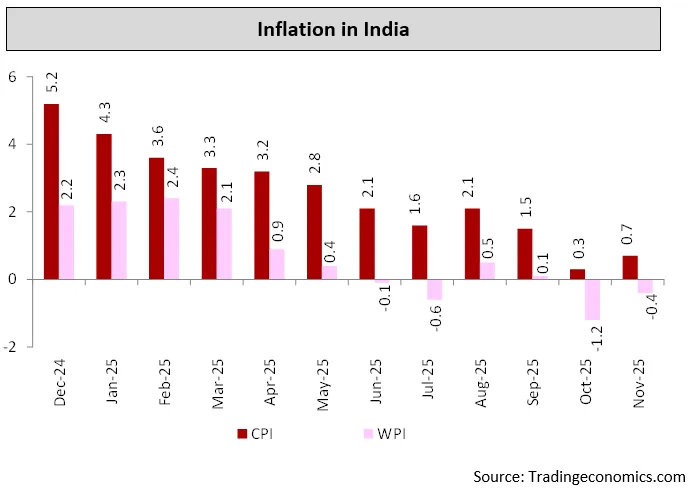Aditya Birla Sun Life Insurance Company Limited
Outlook for the Month of January’26
Economy Review
The key events in the month were –
- Domestic Factors –
a) Trade Deficit – India’s November’25 goods trade deficit narrowed to five months low at $24.3 bn from massive $41.6 bn last month, due to major decline in gold imports and rise in exports.
b) Manufacturing PMI – India’s Manufacturing PMI slips to a 2 year low in December’25 to 55.
c) RBI Policy – In the December’25, RBI has cut the repo rate by 25bps to 5.25% and announced liquidity infusion measures of Rs 1tn OMO and a 3 year $5bn FX swap. The rate cut was an unanimous decision while the stance was maintained at neutral.
d) Fitch Ratings – Fitch Ratings revised India’s GDP growth forecast upward for FY2026 to 7.4% from 6.9% projected earlier.
e) Currency – The Indian rupee breached the 90-per-dollar mark in December’25 as overhang of the US tariff continues and has been hovering around the 90 levels since.
- Global Factors –
a) Federal Reserve – The FOMC has reduced the key policy rates by 25bps to 3.50-3.75%, the third 25 bps cut this year.
b) Bank Of Japan – The BoJ raised its benchmark interest rate by 25 bps to 0.75%, marking its highest level since 1995.
c) Crude Oil – Brent crude oil prices moderated to $62/bbl as expectations of a Russia-Ukraine peace agreement gained momentum, raising hopes for a potential boost in global oil supply.
Domestic Macro Economic Data
Inflation – India’s CPI inflation inched upto 0.7% in November’25 after touching a low of of 0.3% in October’25. India’s WPI inflation came at -0.4% for November’25 Vs -1.2% in October’25, due to low food inflation.

Outlook for Equities
The Indian market remained flat with a 0.3% decline in Nifty during December’25 as India US trade deal remains in limbo and precious metals make record highs. The mid-cap index and small-cap index declined 0.9% and 0.6% respectively. The Indian rupee breached the 90-per-dollar mark in December’25 as overhang of the US tariff continues.
The US FED has reduced the key policy rates by 25bps to 3.50-3.75%. Brent crude oil prices moderated to $62/bbl as expectations of a Russia-Ukraine peace agreement gained momentum. On the domestic front, India’s November’25 goods trade deficit narrowed to five months low at $24.3 bn, due to major decline in gold imports and rise in exports. Government of India has overhauled cigarette taxation, effective 1st February’26. Under the revised framework, there will be a 60% increase in aggregate tax incidence on cigarettes. In the December’25 monetary policy RBI has cut the repo rate by 25bps to 5.25% and announced liquidity infusion measures. Meanwhile, FIIs turned sellers in December’25 selling $2.1bn worth of equities whereas DIIs bought $3.9bn of equities during the month.
Nifty is currently trading at ~20x FY27e P/E, which is its 10 year average. We expect Nifty earnings to grow at 12-13% CAGR over FY25-27. Investors can continue to invest in equities from a medium to long-term perspective.
Outlook for Debt
The minutes of RBI’s December policy iterated a data-dependent approach going ahead. MPC members stated that despite positive growth trend in the past few quarters, there are early signs of moderation in H2FY26, with minimal risk of overheating in the economy. All members pointed out that low and stable core inflation (especially if precious metals are excluded) points to a demand deficit, which is detrimental to growth. While growth forecasts were revised upwards by the RBI, the MPC remains watchful of the low nominal GDP growth and acknowledged that policy support is necessary to boost demand. Governor Malhotra acknowledged that headline inflation in H1FY26 turned out to be much softer than anticipated. With October’26 inflation at 0.3%, real policy rates seemed very high.
The RBI on 23rd December’25 announced further liquidity measures to infuse durable liquidity to the tune of Rs 3 tn into the banking system, OMO purchases to the tune of Rs 2 tn and a $10 bn 3Y FX buy/sell swap was announced. Banking system liquidity turned into deficit amid tax outflows and forex intervention. INR touched a record low of 91.08 against the US Dollar in mid December’25. Aggressive unexpected RBI intervention capped the losses in INR.
India’s goods trade deficit moderated to $24.5 bn, the lowest since June 2025, driven by a sharp fall in gold imports and rise in exports. Services trade surplus improved marginally to $17.9 bn. CPI inflation inched up to 0.71% in November’25 on the back of continued food price deflation and some moderation in bullion inflation. Core inflation moderated marginally to 4.3%. WPI inflation for November’25 was at (-)0.3% YoY. IIP growth accelerated to 6.7% YoY in November’25 led by an across the board recovery in manufacturing.
The FOMC reduced the Federal Funds rate by 25bps to 3.50-3.75% range with a 9-3 majority, in line with market expectations, the Fed also announced buying of treasury securities of $40 bn in the next 30 days. Nonfarm payroll additions in US for November’25 was at 64K. The unemployment rate increased to 4.6% in November’25. Markets are expecting one to three rate cuts by the Fed in CY2026. Bank of Japan hiked their policy rates by 25bps to 0.75%, their highest level since 1995 in an unanimous decision as the policy communique was suggestive of an exit from monetary easing. The European Central Bank (ECB) kept interest rates unchanged in line with market expectations while Bank of England reduced their benchmark policy rates by 25bps to 3.75%.
In the near term, markets await reaction of liquidity measures taken by RBI, union budget in February’26 and confirmation of inclusion of Indian bonds in Bloomberg Global Aggregate Index. Liquidity and rupee movement will also be closely tracked along with CPI data. Progress on trade deal and tax collections trajectory is another indicator to watch. In global markets labour market data from US and FOMC meeting will be crucial for the month. 10 year Gsec closed at 6.59% on 31st December’25 higher by 8bps during the month. 10 year Gsec yield in the near term is likely to be in a range of 6.50%-6.70%. Spread of 10 year Gsec with corporate bond is near 59 bps and is likely to be in a range of 55-65 bps.


